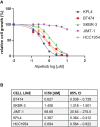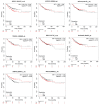The effect of the alpha-specific PI3K inhibitor alpelisib combined with anti-HER2 therapy in HER2+/PIK3CA mutant breast cancer
- PMID: 37469415
- PMCID: PMC10353540
- DOI: 10.3389/fonc.2023.1108242
The effect of the alpha-specific PI3K inhibitor alpelisib combined with anti-HER2 therapy in HER2+/PIK3CA mutant breast cancer
Abstract
Background: HER2 is amplified or overexpressed in around 20% of breast cancers (BC). HER2-targeted therapies have significantly improved the prognosis of patients with HER2+ BC, however, de novo and acquired resistance to anti-HER2 treatment is common. Activating mutations in the PIK3CA gene are reported in ∼30% of HER2+ BC and are associated with resistance to anti-HER2 therapies and a poor prognosis. Here, we investigated the in vitro and in vivo antitumor efficacy of the alpha-specific PI3K inhibitor alpelisib alone or in combination with anti-HER2 therapy using a panel of HER2+ BC cell lines. We also generated models of acquired resistance to alpelisib to investigate the mechanisms underlying resistance to alpha-specific PI3K inhibition.
Materials and methods: PIK3CA mutant (HCC1954, KPL4 and JMT1) and wild-type (BT474 and SKBR3) HER2+ BC cell lines were used. The HCC1954 and KPL4 cells were chronically exposed to increasing concentrations of alpelisib or to alpelisib + trastuzumab in order to generate derivatives with acquired resistance to alpelisib (AR) and to alpelisib + trastuzumab (ATR). The transcriptomic profiles of HCC1954, KPL4 and their AR and ATR derivatives were determined by RNA sequencing. Cell growth was assessed by MTT assay. Changes in the protein levels of key PI3K pathway components were assessed by Western blotting. Gene expression, cellular and patients' data from the Cancer Dependency Map (DepMap) and KMPlot datasets were interrogated.
Results: HER2+ BC cell lines harboring activating mutations in PIK3CA were less sensitive to single or dual anti-HER2 blockade compared to PIK3CA wild-type cells. Alpelisib treatment resulted in dose-dependent inhibition of the growth of cells with or without PIK3CA mutations and enhanced the antitumor efficacy of anti-HER2 therapies in vitro. In addition, alpelisib greatly delayed tumor growth of HCC1954 xenografts in vivo. Functional annotation of the significantly differentially expressed genes suggested the common activation of biological processes associated with oxidation reduction, cell proliferation, immune response and RNA synthesis in alpelisib-resistant models compared with native cells. Eight commonly upregulated genes (log2 fold-change >1, False Discovery Rate [FDR] <0.05) in models with acquired resistance to alpelisib or alpelisib + trastuzumab were identified. Among these, AKR1C1 was associated with alpelisib-resistance in vitro and with a poor prognosis in patients with HER2+ BC.
Conclusions: Our findings support the use of an alpha-selective PI3K inhibitor to overcome the therapeutic limitations associated with single or dual HER2 blockade in PIK3CA-mutant HER2+ breast cancer. Future studies are warranted to confirm the potential role of candidate genes/pathways in resistance to alpelisib.
Keywords: AK1RC1; HER2; PIK3CA; alpelisib; breast cancer; resistance.
Copyright © 2023 Cataldo, De Placido, Esposito, Formisano, Arpino, Giuliano, Bianco, De Angelis and Veneziani.
Conflict of interest statement
Author CD reports personal fees from Roche, AstraZeneca, Lilly, GSK, Novartis, Seagen and Pfizer, Advisory Board for Roche, AstraZeneca, Lilly, GSK, Novartis, Seagen and Pfizer, support for attending meetings and/or travel Roche, AstraZeneca, Lilly, GSK, Novartis, Celgene and Pfizer, grants from Novartis. The remaining authors declare that the research was conducted in the absence of any commercial or financial relationships that could be construed as a potential conflict of interest.
Figures









Similar articles
-
Anti-tumor effects of low-dose metronomic vinorelbine in combination with alpelisib in breast cancer cells.EXCLI J. 2023 Jan 13;22:114-130. doi: 10.17179/excli2022-5064. eCollection 2023. EXCLI J. 2023. PMID: 36998707 Free PMC article.
-
A tipping-point for apoptosis following dual inhibition of HER2 signaling network by T-DM1 plus GDC-0980 maximizes anti-tumor efficacy.Am J Cancer Res. 2021 Jun 15;11(6):2867-2892. eCollection 2021. Am J Cancer Res. 2021. PMID: 34249433 Free PMC article.
-
PLK1 Inhibitor Onvansertib Enhances the Efficacy of Alpelisib in PIK3CA-Mutated HR-Positive Breast Cancer Resistant to Palbociclib and Endocrine Therapy: Preclinical Insights.Cancers (Basel). 2024 Sep 25;16(19):3259. doi: 10.3390/cancers16193259. Cancers (Basel). 2024. PMID: 39409880 Free PMC article.
-
Everolimus versus alpelisib in advanced hormone receptor-positive HER2-negative breast cancer: targeting different nodes of the PI3K/AKT/mTORC1 pathway with different clinical implications.Breast Cancer Res. 2020 Apr 6;22(1):33. doi: 10.1186/s13058-020-01271-0. Breast Cancer Res. 2020. PMID: 32252811 Free PMC article. Review.
-
Role of Alpelisib in the Treatment of PIK3CA-Mutated Breast Cancer: Patient Selection and Clinical Perspectives.Ther Clin Risk Manag. 2021 Mar 5;17:193-207. doi: 10.2147/TCRM.S251668. eCollection 2021. Ther Clin Risk Manag. 2021. PMID: 33707948 Free PMC article. Review.
Cited by
-
Clinical Impact of New Treatment Strategies for HER2-Positive Metastatic Breast Cancer Patients with Resistance to Classical Anti-HER Therapies.Cancers (Basel). 2023 Sep 12;15(18):4522. doi: 10.3390/cancers15184522. Cancers (Basel). 2023. PMID: 37760491 Free PMC article. Review.
-
AP1-mediated reprogramming of EGFR expression triggers resistance to BLU-667 and LOXO-292 in RET-rearranged tumors.J Exp Clin Cancer Res. 2025 May 22;44(1):154. doi: 10.1186/s13046-025-03392-w. J Exp Clin Cancer Res. 2025. PMID: 40405293 Free PMC article.
-
The PIK3CA gene and its pivotal role in tumor tropism of triple-negative breast cancer.Transl Oncol. 2024 Dec;50:102140. doi: 10.1016/j.tranon.2024.102140. Epub 2024 Oct 5. Transl Oncol. 2024. PMID: 39369580 Free PMC article. Review.
-
Steroid hormone receptors, exome sequencing and treatment responsiveness of breast cancer patient-derived xenografts originated in a South American country.Sci Rep. 2025 Jan 18;15(1):2415. doi: 10.1038/s41598-025-86389-x. Sci Rep. 2025. PMID: 39827242 Free PMC article.
-
Alpelisib Therapy in 2 Patients With Congenital Hyperinsulinism.JCEM Case Rep. 2025 Jun 9;3(7):luaf099. doi: 10.1210/jcemcr/luaf099. eCollection 2025 Jul. JCEM Case Rep. 2025. PMID: 40492016 Free PMC article.
References
-
- Xu X, De Angelis C, Burke KA, Nardone A, Hu H, Qin L, et al. . HER2 reactivation through acquisition of the HER2 L755S mutation as a mechanism of acquired resistance to HER2-targeted therapy in HER2+ breast cancer. Clin Cancer Res (2017) 23:5123–34. doi: 10.1158/1078-0432.CCR-16-2191 - DOI - PMC - PubMed
LinkOut - more resources
Full Text Sources
Research Materials
Miscellaneous

